
We independently review everything we recommend. When you buy through our links, we may earn a commission.
We break down our top 10 best Adidas running shoes for 2025
From racing to tempo to slow days to trails, we got you covered
Any questions? Drop it in the comments. Otherwise, let’s get you educated.
Adidas has a long history of excellence within the running world that continues to this day. Quite often, you’ll see podium pairs of Adizero Adios Pro or the $500 Adizero Pro Evo 1 on the feet of some of the top marathoners in the world. That dedication to innovation and performance is not relegated to the pros– it all trickles down across the line and shows up in some of our favorite running shoes, period.
Of course, you’re probably reading this because you want to know which shoes are best for your own running. While all our picks are subjective, we have actually run in all of these models, so we’re able to give you hands-on (er… feet on) feedback about each one. Point being– we feel confident that this list will give you a good idea of what may work for you if you’re looking for a running shoe with the three stripes.
Whether you’re a “3 miles every other day” type runner or a hardcore “always marathon training” one, there’s something on this list for you.
Questions or comments? Leave them below and we’ll do our best to get back to you.
Adidas’ performance line, featuring the most innovative Adidas running shoes.
Sticky and grippy rubber used in some Adidas running shoes, most notably the premium race day shoes.
The newest iteration of Ultraboost, it’s 30% lighter than standard Boost and features a 10% lower carbon footprint.
An EVA-based foam used in the mid-range models of Adidas running.
A Peba-based foam that is the bounciest midsole in the Adidas family. Used primarily in the Adizero line (i.e. performance models).
A new 20% bio-based Peba foam introduced as part of the revamped Supernova lineup
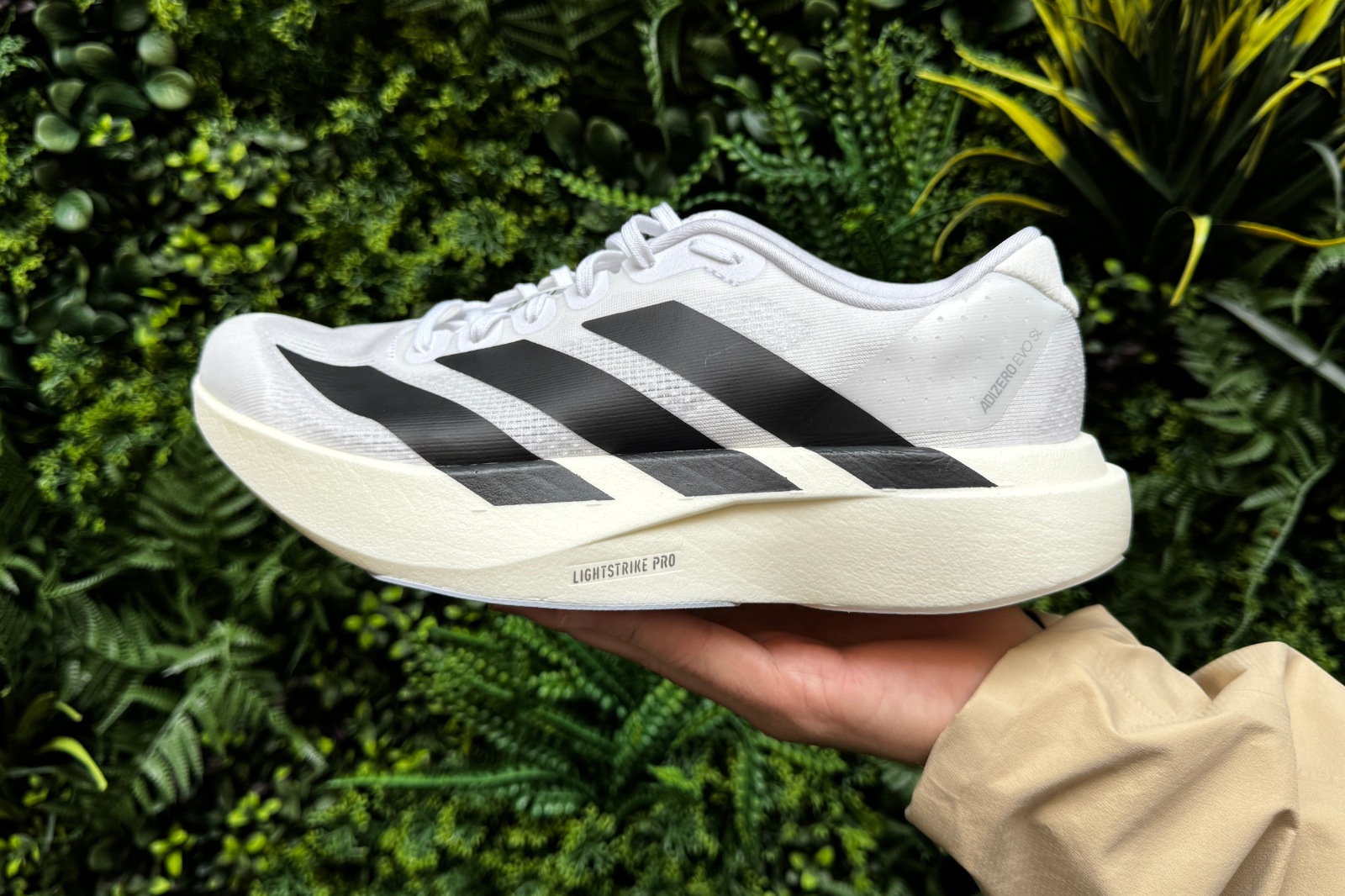
Everything
7.9 oz (224 g) for a US M9, 6.6 oz. (188 g) for a US W7.5
38 mm in heel, 32 mm in forefoot (6 mm drop)
Sometimes simplicity wins. Call it the Pro Evo Lite, or just call it by its real name: the Evo SL. Whatever you call it, this shoe is meant to be the do-it-all training partner for the much more premium Pro Evo 1. Featuring the same Lightstrike Pro midsole foam found in the Adios Pro 3, this debut model comes without carbon fiber EnergyRods, meaning you get a softer ride without sacrificing bounce. We have close to 100 miles in this shoe already, and we can tell you it’s going to be one of the best shoes of 2024 and 2025. A simple mesh upper, a clean design, a great midsole, a Continental rubber outsole, all in a lightweight package. Did we mention it’s $150? Yeah, this one is going to sell fast when it’s available in limited quantities for fall 2024, wide release spring 2025.

Daily training, uptempo
8.4 oz. (238 g) for a US M9,
7.3 oz. (206 g) for a US W7
36 mm in heel, 27 mm in forefoot (9 mm drop)
As an overall package, the Adizero SL 2 may not just be the best overall Adidas running shoe, it may be the best running shoe– period. At $130, it punches way above its weight class thanks to a smooth and bouncy underfoot feel made possible by a full Lightstrike Pro layer embedded into the more traditional Lightstrike 2.0 carrier. A monomesh upper wraps the foot like a running shoe should, especially if you have a more narrow foot. And while the outsole isn’t Continental rubber, we had no problems with it on our end. I took this for a 12-mile long run out of the box and picked it up to tempo pace for the last couple miles and it went right along with everything I threw at it. Truly one of the most memorable shoes of 2024.
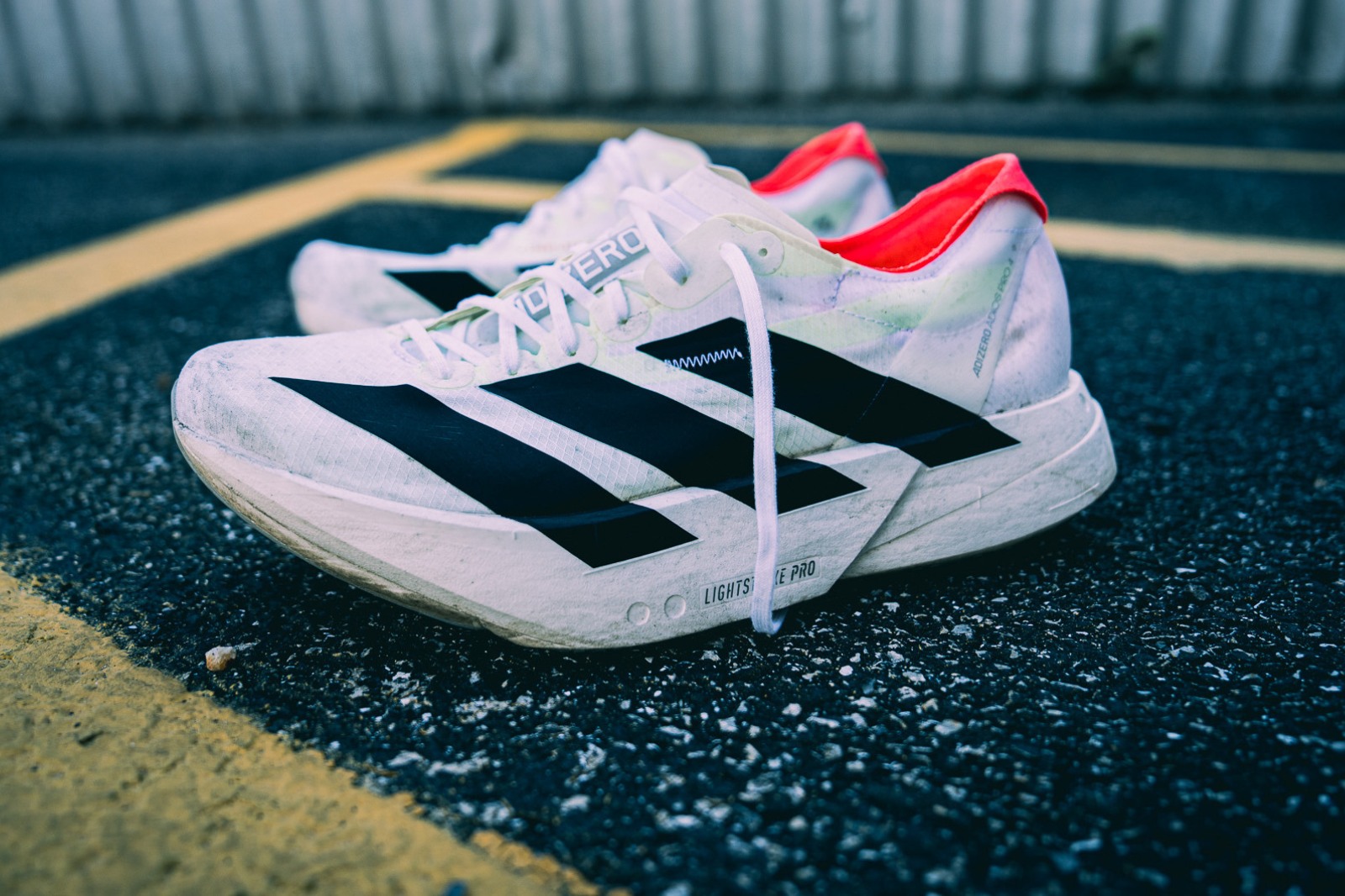
Race day, up to the marathon
7.1 oz. (200 g) for a US M9, 6 oz. (172 g) for a US W7.5
39 mm in heel, 33 mm in forefoot (6 mm drop)
It’s been almost two and a half years since Adidas released the previous version of this shoe. And while we enjoyed that version and raced a couple marathons in it, we’re not gonna lie– we were ready for something new.
In the rear of house kitchen, Adidas was cooking up something good. The final dish? A total overhaul of the Adios Pro. Now one of the lightest race day shoes on the market, the Adios Pro 4 also features some of the components of its premium priced sister in the Pro Evo 1. Namely, the carbon fiber EnergyRods design and placement and midsole geometry. A new stretch woven upper is soft, light, and luxurious, wrapping the foot perfectly from heel to toe. The reformulated rubber outsole with strategically placed Continental rubber in the toe provides fantastic traction on wet or dry surfaces.
Our only caveat: be careful of the sizing as it seems to run slightly short this time around. In any case, Robbe landed a PR at the Berlin Marathon in the shoe, so this is a shoe that goes on the trophy shelf. Hopefully it does the same for you. Available January 2025.
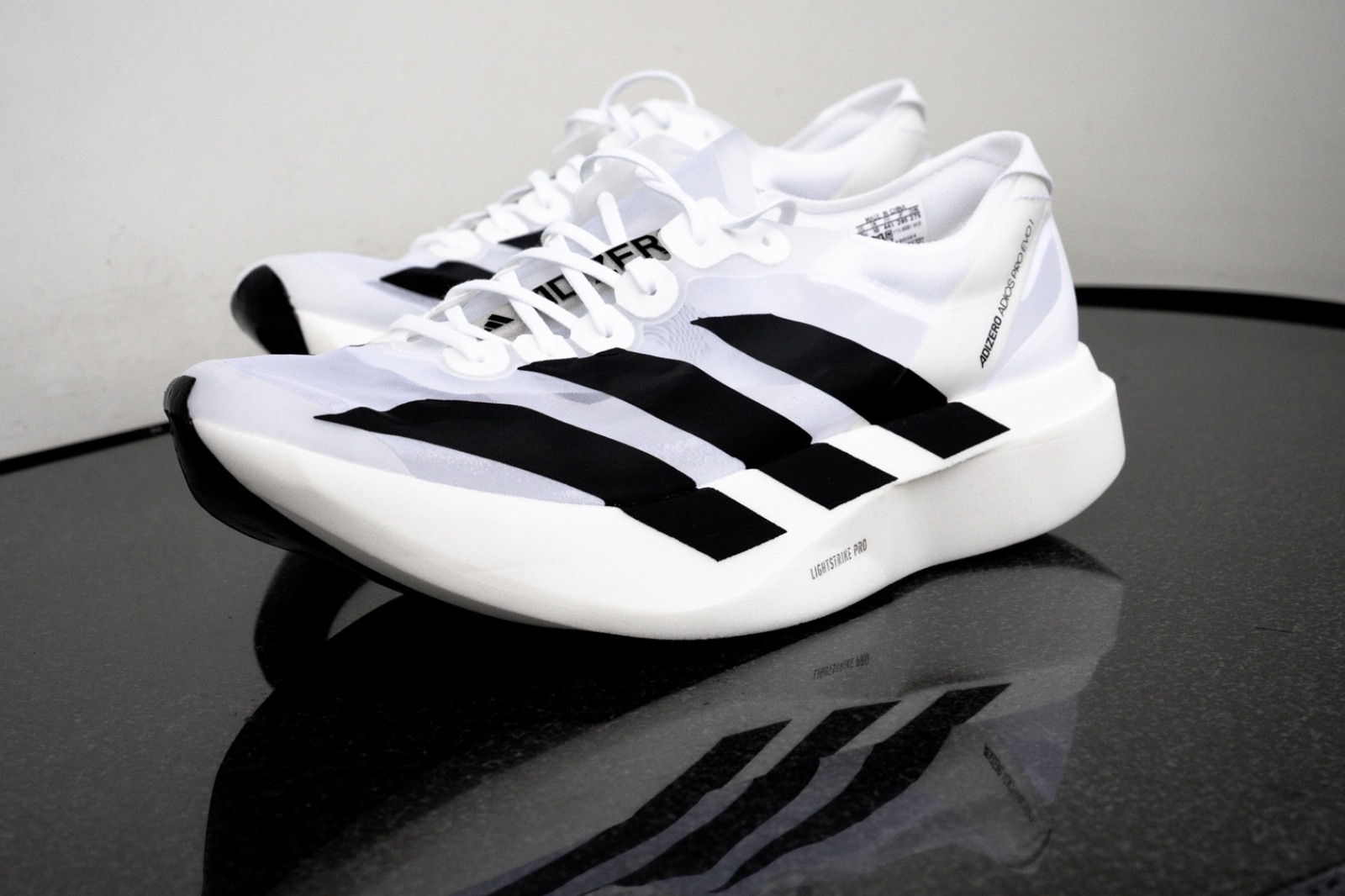
The most serious marathon of your life
5.1 oz. (144 g) for a US M10.5 (Unisex sizing)
39 mm in heel, 33 mm in forefoot (6 mm drop)
Alright, so this one might not feel like a fair pick for most runners — heck, only Thomas has a pair in the office. That said, it’s worth a mention because it is hands-down the best running shoe that Adidas has ever made. The Adios Pro Evo 1 weighs next to nothing, yet it packs all of the technology that Adidas can fit into one racing shoe, complete with a price to match.
Somehow, the Adios Pro Evo 1 is a whopping 40% lighter than the Adios Pro 3 but still comes in with a barely legal 39 mm of foam in the heel and a new non-compression formula of Lightstrike Pro. As you might expect, the shoe is pretty light on the padding, since every last scrap of fabric and foam adds precious grams, so make sure you have a pair of socks that you really like underneath.
Adidas won’t tell us just how the non-compression midsole is made, but we have our guesses. By not compressing the foam, it’s able to hold more air in the midsole, which, in turn, maintains more bounce underfoot. Of course, that means it’ll compress over time, which is why you can probably only count on the Pro Evo 1 for a precious few miles before it dies.
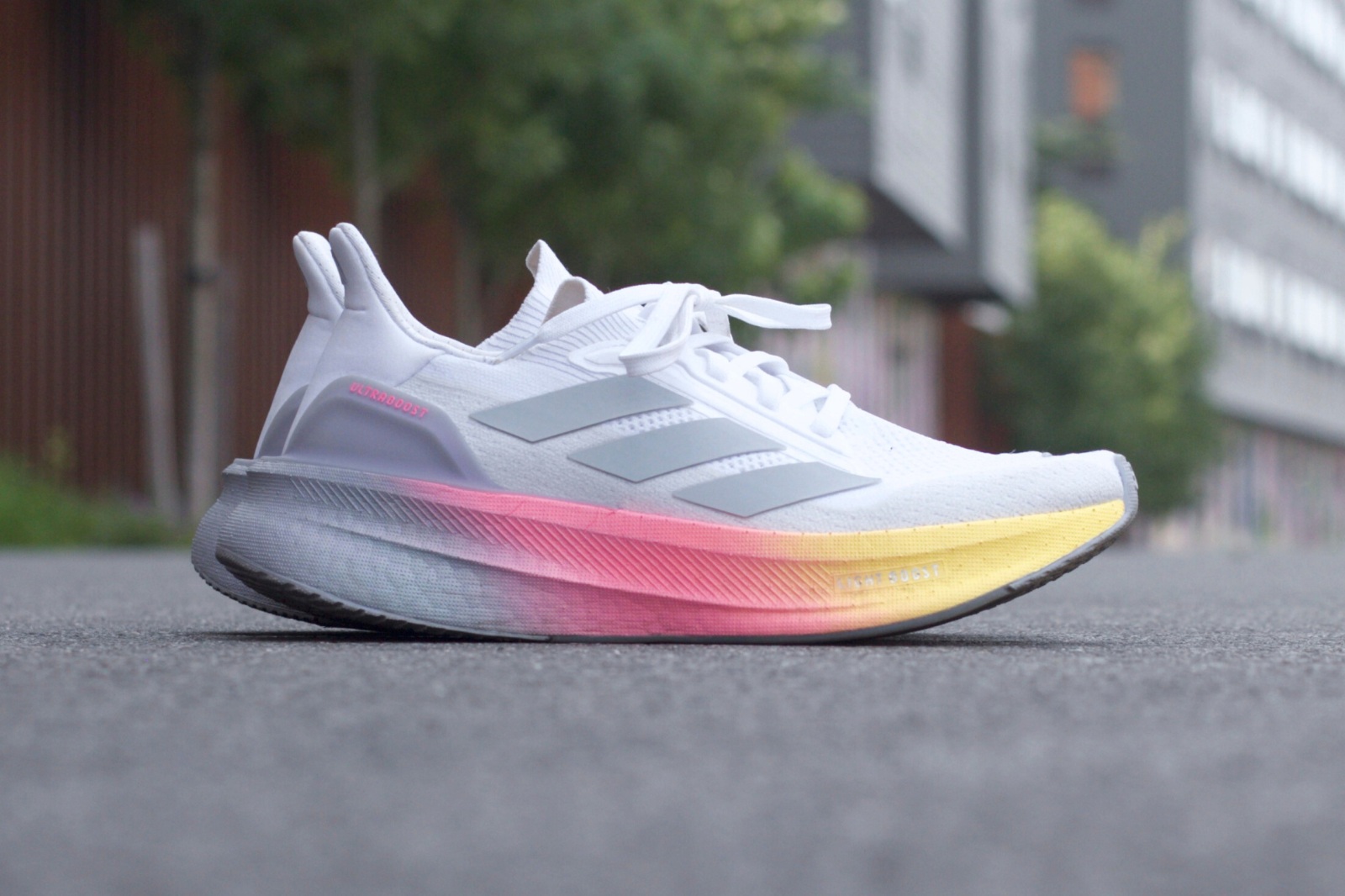
Daily training, lifestyle, travel
9.7 oz. (275 g) for a USM9
38 mm in heel, 28 mm in forefoot (10 mm drop)
Every year, Adidas promises that the Ultraboost is a great running shoe, and every year we’re disappointed. It’s always heavy, the Boost has been outdated, and while it looks great, it just lost its running appeal some time ago. So when we got this shoe for testing, we weren’t too excited.
And then we ran in it. Boy, have the tables turned. Because the Ultraboost 5X is a great shoe for everything: running, lifestyle, travel, and more. The Light Boost midsole has been reformulated to feel softer, lighter, and bouncier. The soft knit upper is luxurious (though it’s a bit warm). And the overall package is surprisingly light, coming in under the weight of competitors like the Asics Gel-Nimbus 26. It’s really a
If you’re looking for a great casual shoe that you can wear in public but also get in some miles, you can’t do much better than this.
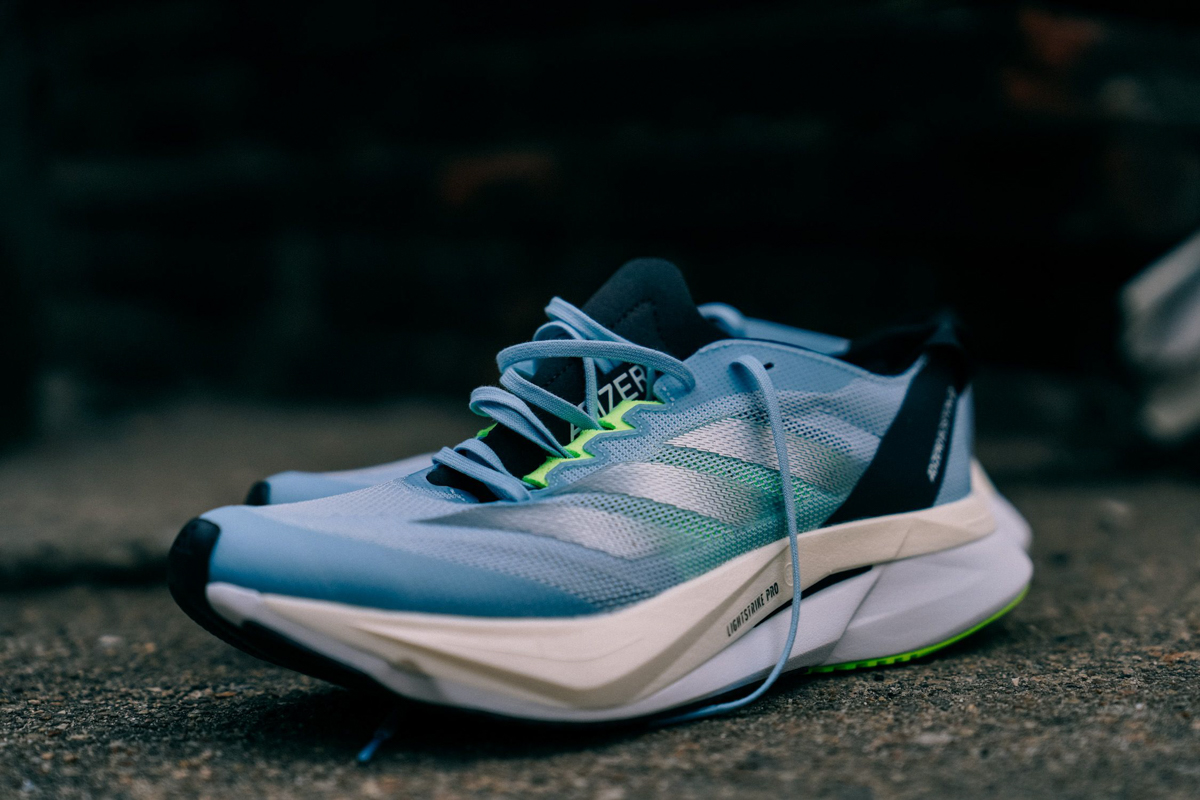
Oh, baby, the Boston is back. We were pretty vocal about how much we hated the last two versions of Adidas’ do-it-all trainer, and now we’ll probably be just as loud about the fact that it’s been fixed. What’s the secret, you ask? Well, quite simply, Adidas has fixed everything we hated about the midsole — simple as that. The updated Boston 12 now has more Lightstrike Pro in the forefoot, a softer formulation of Lightstrike in the heel, and a reworked set of EnergyRods sandwiched in between.
Granted, this isn’t just a brand-new version of the shoe that it was before, either. Adidas widened the forefoot, which gives it more inherent stability, while the Energy Rods keep you bouncing right along. You get a full helping of Continental rubber across the outsole, too, which is welcome protection from the often slippery boards of the Baltimore promenade.
Robbe equated the Boston 12 to the Adios Pro Lite, which kind of makes sense when you think about it. This shoe has more stack than the Takumi Sen 10 and, outside of the Lightstrike 2.0 in the heel, offers a very similar makeup to the premium racer. Meg also compared it to a supertrainer given the presence of Adidas’ peba-based Lightstrike Pro, but this is one that you can (legally) race in.
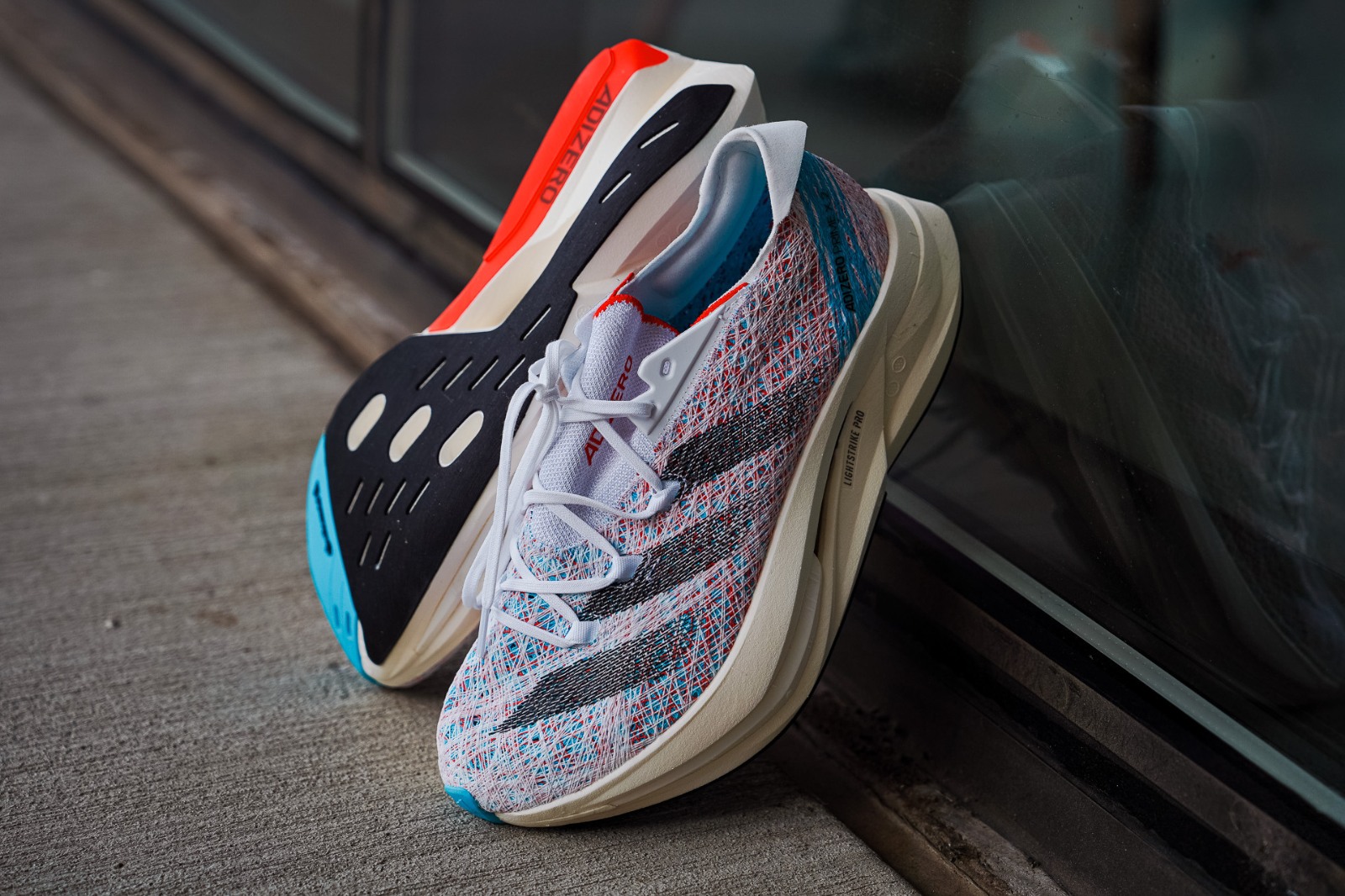
Long runs with an illegal amount of cushion
10.8 oz (306 g) for a US M9 (Unisex sizing)
48 mm in heel, 41 mm in forefoot (7 mm drop)
Well, this might be one of our more controversial picks for the best Adidas running shoes, but only because it’s so different from what we expected. When we first tried on the Prime X2 Strung more than a year ago at The Running Event, we thought it was going to change the game. It was all that and more — literally.
By the time it got to us, it felt like we were running in a completely different shoe. Sure, the Prime X2 Strung still has two carbon-infused plates and three layers of Lightstrike Pro foam, but they’re a bit heavier and a bit less stable than we initially experienced. However, the Prime X2 Strung still seems to work like a dream for some members of our team, so we can’t rule it out for everyone.
Oh, and the 3D-printed, or Strung, upper is still a treat. Using athlete data, Adidas has mapped out and programmed different fiber properties thread by thread so that you get an upper that’s designed for support, flex, and breathability, all in one piece of material. It fits much better than Adidas’ more traditional uppers and doesn’t seem to run quite as long, either.
All that tech and premium-grade construction is still gonna cost ya to the tune of $300. They say all you need is a pair of shoes to run, but in this case, you may need a second mortgage. Just make sure you can still return this one in case it doesn’t quite work for you…
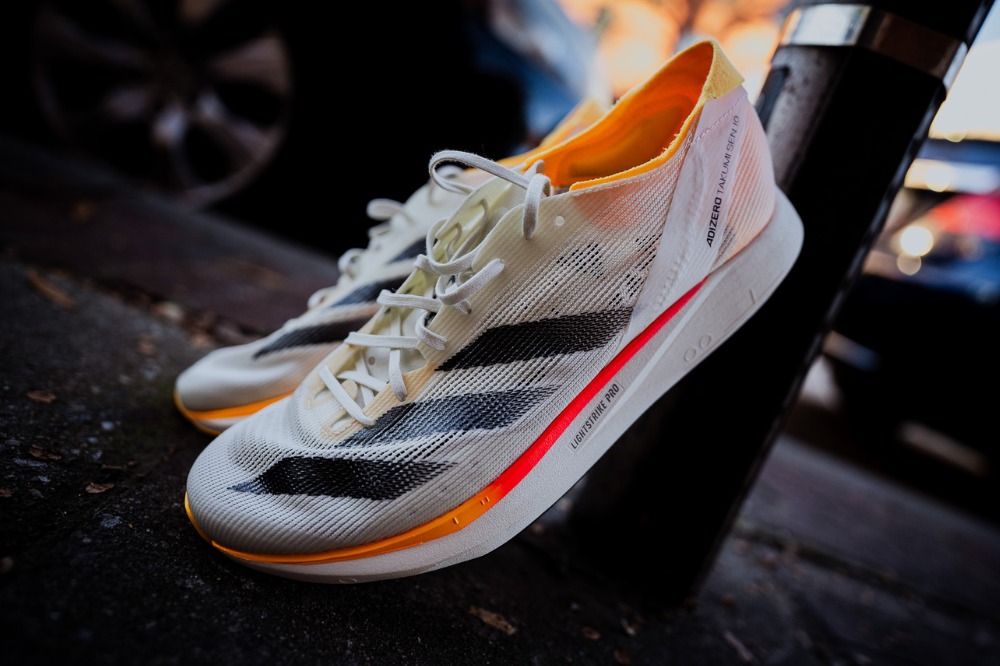
Race day up to a half marathon, tempo runs
6.9 oz (198 g) for a US M9,
5.8 oz. (165 g) for a US W7.5
33 mm in heel, 27 mm in forefoot (6 mm drop)
Sometimes, you don’t need to max out the midsole to make a great racing shoe. The Adidas Takumi Sen 10 is a great example of what we mean when we say that. Hands down, this is the best tempo shoe money can buy and easily stands up against the big boys in any distance under 10 miles.
It’s such a perfect combination of everything — the Lightstrike Pro midsole, fiberglass EnergyRods, and Celermesh upper all combine to give you a dagger of a shoe. It’s so fast, it’s so light, it feels so good. Oh, and it comes in at under $200, so you can feel pretty good about lacing it up without burning all the way through your wallet. Adidas hasn’t actually changed the Takumi Sen too much in the last few years, largely running with the same midsole shape, but now the shoe has a lighter, more breathable upper to match.
I don’t have anything else to say except that the shoe runs long, so go down a half-size if you’re on the lower end of the size range. We’ve said it time and time again, so if you get the wrong size, it’s probably on you at this point.
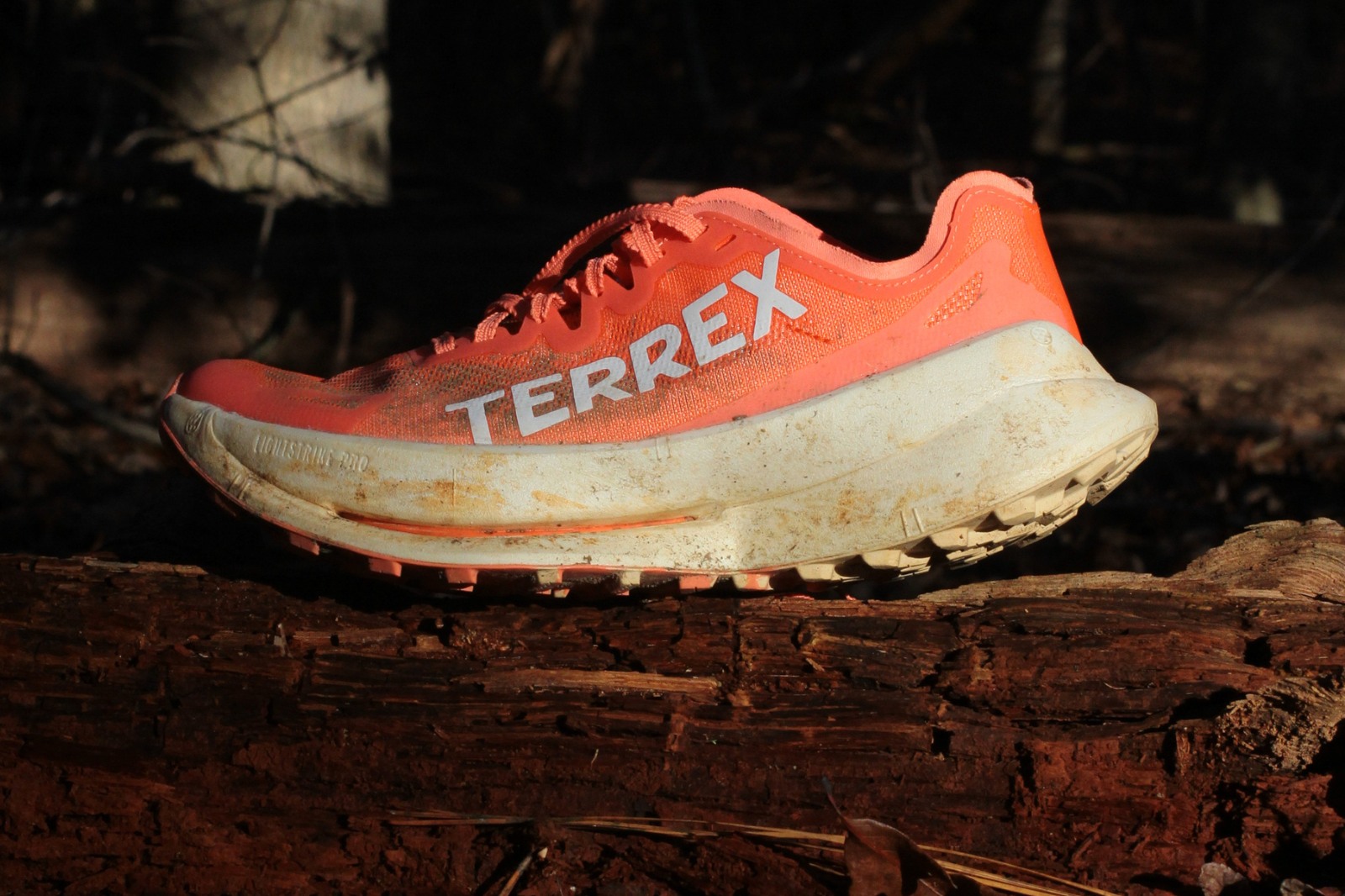
Race day on the trails
9.5 oz. (270 g) for a US M9,
8.1 oz. (230 g) for a US W7
38 mm in heel, 30 mm in forefoot (8 mm drop)
Alright, let’s get a little muddy. We’ve touched on a bunch of Adidas road running shoes so far, but the Terrex line is just as well-regarded when it comes to the trails. Robbe put plenty of miles into the Agravic Speed Ultra while training for the HAT 50k, and he’s got plenty of thoughts on the trail racer.
It’s not necessarily a flashy trail shoe, preferring one bold color for the upper instead of Nike’s louder line of trail shoes, but man, it’s a good-looking runner. Robbe pointed out that Adidas’ mesh is lightweight and form-fitting but still offers surprisingly good lockdown, given the lack of overlays. Think of it as fitting like the Takumi Sen, but with a bit more structure around the heel. Part of that excellent lockdown comes from sawtooth laces that you’ll immediately recognize if you’ve run in a recent racer from Nike, Asics, and plenty of others.
Perhaps the best part of the Adidas Terrex Agravic Speed Ultra is the fact that it’s stable — something that trail racing shoes often struggle with. It has a wider forefoot with EnergyRods running through it like metatarsals, giving your toes another set of toes to ride along.
Have something to say? Leave a Comment

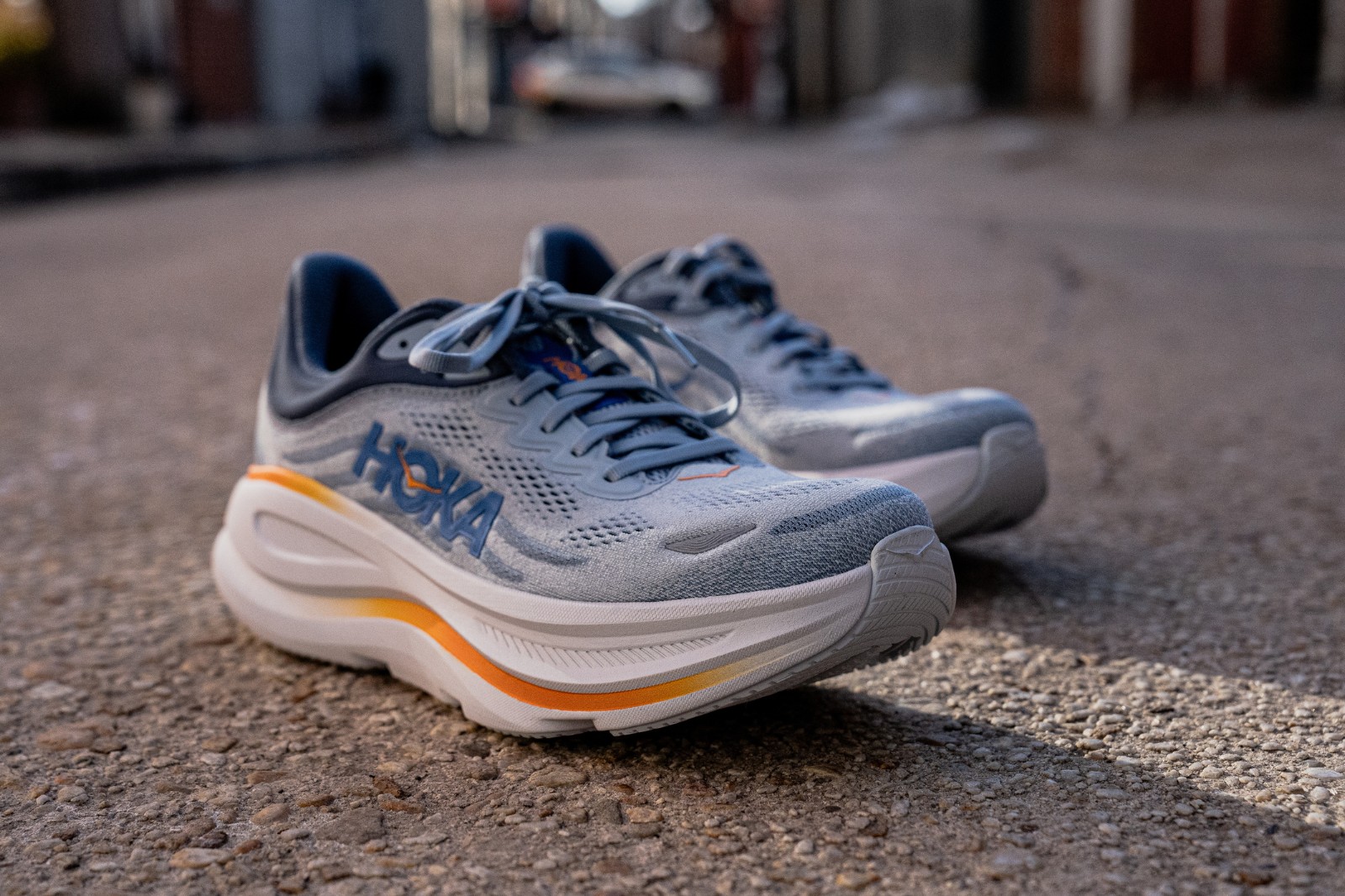
Lightstrike Pro is TPEE, not a PEBA foam…
I love the Boston 12 (having been a fan of the 7 and 9 before that), but is there a reason to choose the Boston over the Evo SL? Really keen to understand the relative pros and cons of each, as both get billed a premium training versions of the race day shoes. Thanks for all the great info, guys!